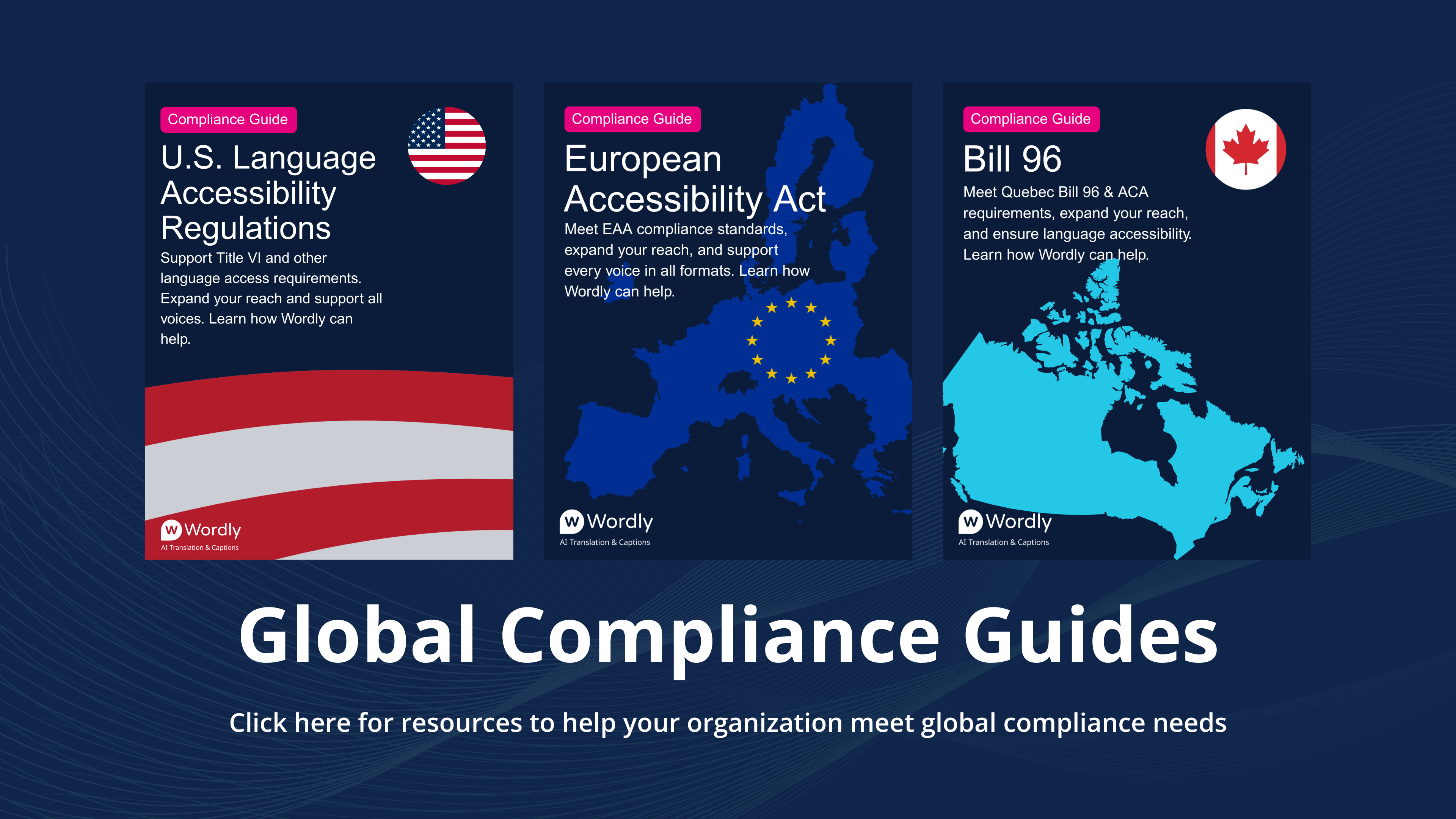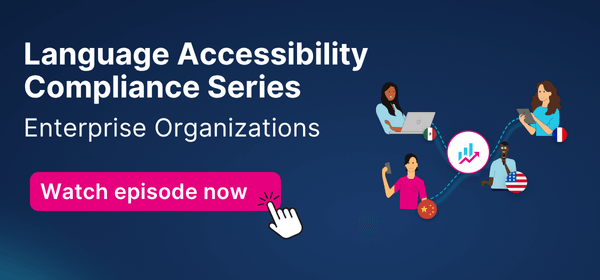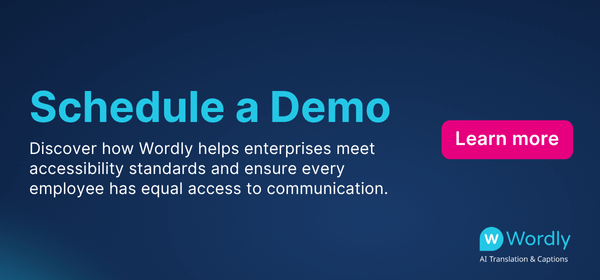Worldly als eines der am schnellsten wachsenden Softwareunternehmen in den USA ausgezeichnet — Mehr erfahren

Enterprises today operate across borders, serve diverse customers, and employ global teams. With this reach comes both a responsibility and a legal requirement to provide accessible communication for all. This guide explains how enterprises can align with ADA requirements, apply Section 508 standards, and adopt WCAG 2.1 guidelines – while also addressing cultural nuance, security, and accessibility best practices.
Laws like the Americans with Disabilities Act (ADA), Section 508 of the Rehabilitation Act, and WCAG 2.1 accessibility standards set clear expectations around accessibility. At the same time, advances in AI translation and captioning from companies like Wordly are transforming how enterprises can meet these obligations at scale.
The Americans with Disabilities Act (ADA) requires enterprises with 15 or more employees to provide effective communication for individuals who are deaf, hard of hearing, or have limited English proficiency. In some states, like California, even smaller employers are covered under local laws.
For enterprises, compliance starts with three key steps:
The Department of Justice recommends using census data to identify the most common non-English languages in your area — a critical step for enterprises operating in diverse markets.
Language interpretation services should be built into corporate accessibility plans to ensure both employees and customers can request support when needed
Language access isn’t limited to in-person interactions — it extends to your enterprise’s digital ecosystem.
Two specific principles matter for language access:
Adopting WCAG standards is not just about compliance — it ensures smoother experiences for multilingual users and reduces the risk of lawsuits.

AI translation tools and translation software are powerful for scaling communication across global offices. They improve efficiency, reduce delays, and can dramatically cut costs compared to human interpreters.
Still, cultural nuance matters — so when choosing an AI translation solution, ensure it supports language dialects and includes glossary technology to maintain accuracy and respect local context.
Corporate requirements depend on workforce size, customer base, and industry. Under ADA Title III, businesses must make customer interactions accessible, which increasingly includes digital experiences.
While laws like Section 508 apply to federal agencies, their standards have influenced enterprise best practices. WCAG, though not always legally binding for private companies, is widely adopted as the safest way to demonstrate accessibility and avoid litigation.
In practice, enterprises should treat WCAG as a compliance baseline. It’s not only about avoiding risk — accessibility demonstrates corporate values and strengthens brand trust.
.png)
One of the biggest concerns enterprises face is maintaining security and privacy while enabling rapid translation. Frameworks like SOC 2 are widely used for service providers handling sensitive data, ensuring controls around security, confidentiality, and processing integrity.
Enterprises adopting AI translation should choose vendors that:
This balance ensures compliance doesn’t come at the expense of security.
Wordly security ensures customer data is protected in alignment with industry best practices, and Wordly is committed to delivering a secure solution across all of our services.
Global enterprises thrive when communication is seamless. Supporting employees and customers in multiple languages reduces barriers and increases efficiency.
AI-powered tools, including live translation, make day-to-day collaboration easier. For example, instead of waiting for human interpreters, AI translation can provide near-instant communication between global teams, while still leaving room for human review when accuracy is critical.
By removing language barriers, enterprises can:
AI captioning is one of the simplest, most effective ways to ensure accessibility. It benefits not only deaf and hard-of-hearing employees, but also:
Captions also demonstrate inclusivity, removing the burden from individuals who might otherwise have to request accommodations.
With an estimated 20% of the global population experiencing some form of hearing loss, captioning signals that your enterprise values access for all.

Even well-intentioned enterprises can stumble. The most common mistakes include:
Avoiding these pitfalls will help you strengthen compliance and employee engagement.
What compliance standards should enterprises prioritize?
Enterprises should align with ADA, Section 508, and WCAG 2.1 Level AA standards. While not always legally binding, WCAG has become the global benchmark and is increasingly cited in lawsuits.
How does AI translation support enterprise compliance?
AI translation provides real-time, scalable communication in dozens of languages, helping enterprises meet accessibility requirements while reducing reliance on costly human interpreters.
Why should enterprises consider Wordly for language access?
Wordly delivers AI translation, captions, and transcripts instantly, without extra equipment, making it easier for enterprises to comply with accessibility laws and support global teams.
How accurate and reliable is AI translation today?
AI translation is remarkably accurate, improving continuously with machine learning. For most enterprise use cases — from meetings to digital events — it delivers real-time results that are faster and more scalable than traditional solutions.
What are the risks of not meeting language access requirements?
Enterprises face legal exposure, reputational damage, and lost business opportunities if they fail to provide accessible communication. Investing in solutions like Wordly can help to mitigate these risks.

Language access compliance is more than a legal requirement — it’s a business advantage. Enterprises that commit to accessibility gain stronger teams, happier customers, and greater protection from risk.
Ready to take the next step? Book a demo today to see how AI translation with Wordly can help your enterprise organization.
Disclaimer: Content provided is for informational purposes and does not constitute legal advice. Agencies should consult their legal advisors regarding compliance obligations.
